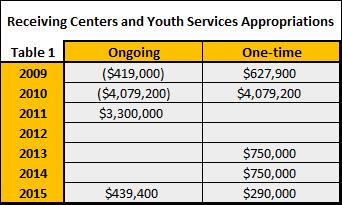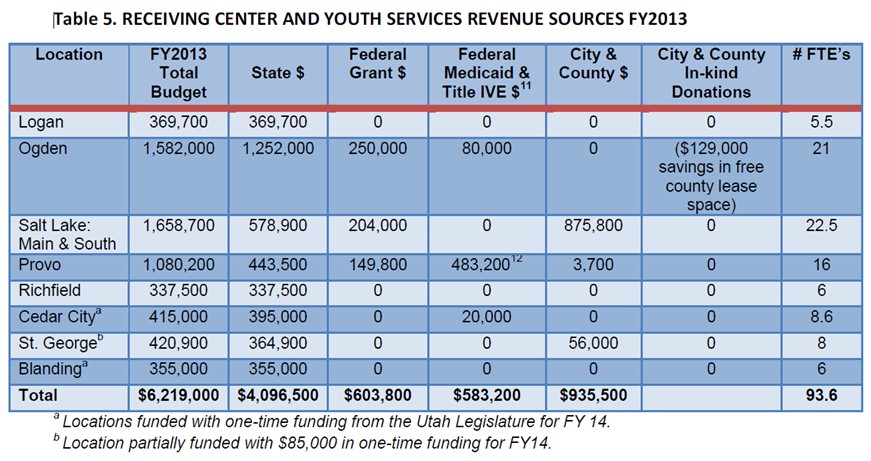Fiscal Highlights - May 2014
|
DJJS - Receiving Centers and Youth Services -
Zackery N. King ( What is the next step for receiving centers and youth services? Receiving centers and youth services (RC&YS) have been provided by state or local government in one form or another for many years in Utah, and currently serve a unique niche in the continuum of programming provided by the Division of Juvenile Justice Services (DJJS). They are a front-end service to treat youth and families, with the aim of preventing youth from penetrating further into the DJJS system. Due to tightened budgets and recent federal Medicaid changes, revisiting the service delivery model and how RC&YS are funded statewide is recommended. The Legislature has an opportunity during the 2015 General Session, to provide important policy direction for RC&YS and to solidify a state-local partnership in funding them. With this state-local funding approach, the potential exists to allocate state funds for RC&YS more efficiently, and to expand their scope of service throughout the state. The Legislature has already begun taking the next step through both legislation and the appropriations process in the 2013 and 2014 General Sessions. Legislative action taken during these general sessions has initiated a transition from a state funded model to a state-local funding model for RC&YS. A summary explanation for this is due to the heavy utilization of RC&YS by local government entities. Local governments value these programs and have expressed a desire to continue maintain them. Additionally, finding a stable funding model to support these programs is a motivation for recent actions taken by the Legislature (see Section 1 in the Appendix for additional detail). Additional steps the Legislature can take for RC&YS are:
Vantage Point Example A potential state-local funding model is found in the Utah County receiving center -- Vantage Point. Vantage Point is an added service to Wasatch Mental Health (WMH) -- the local mental health center -- and is funded largely with Medicaid dollars available through WMH. The state does provide funding for Vantage Point, but this amount is less than 50% of its operating budget (see Table 5 in Section 1 of the Appendix for a funding breakdown). If Utah County and the surrounding municipalities contributed funding to Vantage Point, ongoing state funds could be used to support these services in other areas. The state has 13 local mental health special service districts -- could the Vantage Point/WMH model be a statewide model for RC&YS? The remainder of this newsletter reviews historical appropriations to RC&YS, and summarizes legislative action taken in recent general sessions to create a state-local partnership in funding them. Receiving Centers and Youth Services Budget Summary DJJS budgets for RC&YS are split - depending upon geography - between two line items, with total spending at approximately $6.2 million dollars (FY 2013 budget). The State of Utah currently funds about 94 FTEs to administer these programs and services at nine locations. Appropriations for RC&YS has been an item of discussion dating back to the 2008 2nd Special Session, when federal Medicaid reductions and coinciding state budget reductions were being implemented (see Section 1 in the Appendix for additional detail). Since then, RC&YS have been allocated one-time funds to aid in filling budget needs as the aforementioned reductions have taken effect on operations. Some impacts at the state level include the closing of a satellite program in Davis County, reduction in available beds at receiving centers, and reduced hours of operation at a majority of locations. Table 1 below shows appropriations by fiscal year since 2009.
2013 General Session and Interim During the 2013 General Session, the Legislature passed S.B. 218, "Receiving Centers Funding Amendments". This bill specifies that funding for RC&YS "is intended to be broad based" and include "federal grant money, local government money, and private donations." In addition to this legislation, a $750,000 one-time appropriation was made to sustain service delivery in Blanding and Cedar City through June 30, 2014. Accompanying intent language required an in-depth report on current RC&YS statewide. In August of 2013, the Executive Offices and Criminal Justice Appropriations Subcommittee (EOCJ) held an interim meeting where DJJS presented the intent language report, and RC&YS were discussed at length. One result of this interim meeting was the CCJJ working group assignment to focus on funding models for that include local government participation. 2014 General Session Discussions about RC&YS continued in EOCJ's January 31 budget hearing during the 2014 General Session. On this day, the CCJJ working group presented its report focused on potential funding models which include local government participation. Thirteen recommendations came out of this report and are included in Section 2 in the Appendix. As shown in Table 1 above, the Legislature appropriated a combination of ongoing and one-time funding for RC&YS to begin implementation of the CCJJ Working Group report recommendations in FY 2015. The Legislature also passed accompanying intent language with these appropriations: It is the intent of the Legislature that the $439,400 ongoing General Fund and $290,000 one-time General Fund Conclusion The Legislature has initiated a state-local funding model for RC&YS in the past two general sessions. By funding RC&YS with a state-local partnership, these programs and services can potentially be expanded to a greater population in the state. The nature of these programs and services creates numerous instances where cross-over treatment and programming between DJJS, the Division of Child and Family Services (DCFS), and multiple local government entities occurs -- Vantage Point/WMH in Utah County is an example. RC&YS fill a unique niche in the treatment of youth at the front end of Utah's DJJS model which can divert youth from penetrating the system further - this is beneficial to the youth and their families, and also less costly to the state. Local government entities have expressed concern over the prospect of closing these programs in their communities. For the optimal treatment of youth and betterment of their families, and for the efficient and effective use of taxpayer dollars spent on juvenile justice in Utah, it is recommended that further steps be taken by the Legislature to solidify recent actions taken in the 2013 and 2014 General Sessions and to provide direction on how these programs will be operated in the future. APPENDIXSection 1. Receiving Centers and Youth Services Funding BreakdownThe table below is taken from the intent language report, prepared by DJJS, and subsequently presented to EOCJ in its August 2013 interim meeting. It shows the multiple funding models currently in place for receiving centers and youth services statewide. FY 2013 Stats/Details
Section 2. CCJJ Working Group Report RecommendationsThe CCJJ Working Group Report was presented to EOCJ during the 2014 General Session. The 13 recommendations from the report are included below. Recommendations 1, 8, 9, 10, and 11 were included in intent language accompanying the Legislature's 2015 appropriation for receiving centers and youth services. 1. Stabilize funding for Youth Services and Juvenile Receiving Centers (JRC) with on-going State dollars as the budget allows. 2. Repackage Youth Services and JRC to clearly identify the services provided. 3. Youth Services and JRC should develop new and diverse partnerships with local and state organizations, including local mental health and substance abuse authorities. 4. An information campaign should be undertaken by JJS and local partners to ensure communities are aware of services offered by Youth Services and JRC. 5. A formula for distributing state dollars is not recommended as each site varies in program administration. State funding should be allocated based on the individual needs of each community. 6. Expand pick-up orders to Youth Services to include status offending youth who fail to comply with probation orders. This would be in lieu of pick-up orders to detention and at the discretion of the judge. 7. Pick-up orders to Youth Services should be offered wherever youth service beds are available. 8. Should match from local governments be necessary, it should be equitable and implemented over three to five years. This would allow local communities to build capacity within their infrastructure and budgets. 9. Agencies who bring youth from outside the JRC home county should contribute proportionally to any match requirement. 10. Any data used in a formula should be averaged over at least three years to reduce year to year volatility. 11. The Legislature should consider providing base funding plus local match to expand Juvenile Receiving Centers and Youth Services to new communities. 12. Billing private insurance for services is not feasible for JJS and should not be done. However, billing Medicaid and private insurance should be considered where partnerships with local mental health and substance abuse authorities have been established and should be encouraged to expand in areas where there are not current partnerships in place. 13. JJS should continue to gather and record detailed Youth Services and Receiving Center data. |
$107 Million of Excess Federal TANF Spending Authority - Stephen C. Jardine The Department of Workforce Services (DWS) administers the federal Temporary Assistance for Needy F...Division of Air Quality: New Appropriations Update - Angela J. Oh Air quality was a priority during the 2014 General Session. Lawmakers passed legislation to cut emi...DJJS - Receiving Centers and Youth Services - Zackery N. King What is the next step for receiving centers and youth services? Receiving centers and youth s...Economic Development Incentives - Andrea Wilko Financial incentives are provided through the Utah Governor's Office of Economic Development and th...Higher Education Tuition Increases for 2014-2015 - Spencer C. Pratt Following the 2014 General Session, the State Board of Regents met and approved a 4.0% first-tier t...How Will Quagga Mussel Impact Utah Financially? - Ivan D. Djambov Now that the invasive quagga mussels are established in Lake Powell, how long before they get to ot...Is there a Relationship between Educational Attainment and Employment Growth? - Thomas E. Young The Education Interim Committee heard presentations on long-term planning for educational attainmen...Jail Reimbursement Program and Appropriations - Fiscal Years 2011-15 - Gary K. Ricks The Jail Reimbursement Program provides reimbursement to Utah counties for days spent in county jai...Medicaid and CHIP Enrollment Trends Since the Beginning of Mandatory Medicaid Expansion - Russell T. Frandsen Since the beginning of the Medicaid mandatory expansion as part of federal health care reform in Ja...Sequestration Update - Steven M. Allred In December 2013, Congress passed the Bipartisan Budget Act of 2013 (BBA), providing states some ce...The Billion Dollar Retirement Gap - Brian D. Fay In 2008, the Utah Retirement System (URS) experienced investment losses of nearly 25 percent, leavi... |
Reports/Archive | Budget Process | Office Background | Who's Who | Organization Chart
Office of the Legislative
Fiscal Analyst
House Building, Suite W310
Salt Lake City, UT 84114
Phone (801) 538-1034 Fax (801) 538-1692

